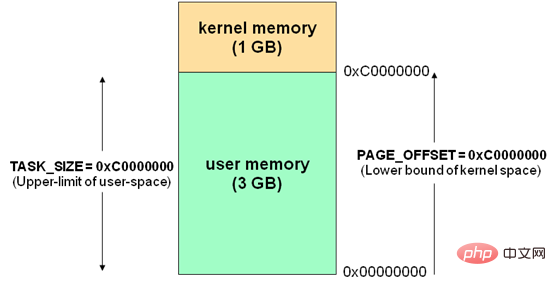Home >Operation and Maintenance >Linux Operation and Maintenance >Detailed explanation of Linux user space and kernel space
Detailed explanation of Linux user space and kernel space
- 藏色散人forward
- 2020-12-08 17:01:104770browse
Recommended: "Linux Video Tutorial"
1. Introduction
- Linux operating system and driver operation In kernel space, applications run in user space. The two cannot simply use pointers to transfer data. Because of the virtual memory mechanism used by Linux, user space data may be swapped out. When the kernel space uses user space pointers, the corresponding data may not be in memory. The memory mapping of user space adopts segment page type, while the kernel space has its own rules; this article aims to explore the address mapping of kernel space.
- os allocates an independent, continuous, virtual address memory space to each process. The size is generally 4G (32-bit operating system, that is, 2 to the 32nd power), in which the high address value is The memory space is allocated to os, linux os occupies 1G, and window os occupies 2G; the remaining memory address space is allocated to processes.
- Usually the 32-bit Linux kernel virtual address space is divided into 0~3G as user space and 3~4G as kernel space (note that the linear address that the kernel can use is only 1G). Note that this is the 32-bit kernel address space division, and the 64-bit kernel address space division is different.

- Process addressing space 0~4G
- The process is in user mode Only 0~3G can be accessed, and 3G~4G can only be accessed when entering the kernel state
- The process enters the kernel state through system calls
- The 3G~4G part of the virtual space of each process is the same
- The process entering the kernel state from user mode will not cause changes in CR3 but will cause changes in the stack
2. Linux kernel high-end memory
1. Origin
When the kernel module code or thread accesses memory, the memory addresses in the code are all logical addresses, and corresponding to the real physical memory address, the addressone-to-one is required Mapping, for example, the physical address corresponding to logical address 0xc0000003 is 0×3, the physical address corresponding to 0xc0000004 is 0×4,…, the relationship between logical address and physical address is
Physical address = Logical address – 0xC0000000 : This is the address translation relationship of the kernel address space. Note that the virtual address of the kernel is at the "high end", but the physical memory address mapped by ta is at the low end.
| Logical address | Physical memory address |
| 0xc0000000 | 0×0 |
| 0×1 | |
| 0×2 | |
| 0×3 | |
| … | |
| 0×20000000 | |
| … | |
| 0xffffffff | 0×40000000 ?? |
| Logical address | Physical memory address |
| 0xF8700000 | 0×80000000 |
| 0xF8700001 | 0×80000001 |
| 0xF8700002 | 0×80000002 |
| … | |
| 0x800FFFFF |
The above is the detailed content of Detailed explanation of Linux user space and kernel space. For more information, please follow other related articles on the PHP Chinese website!




